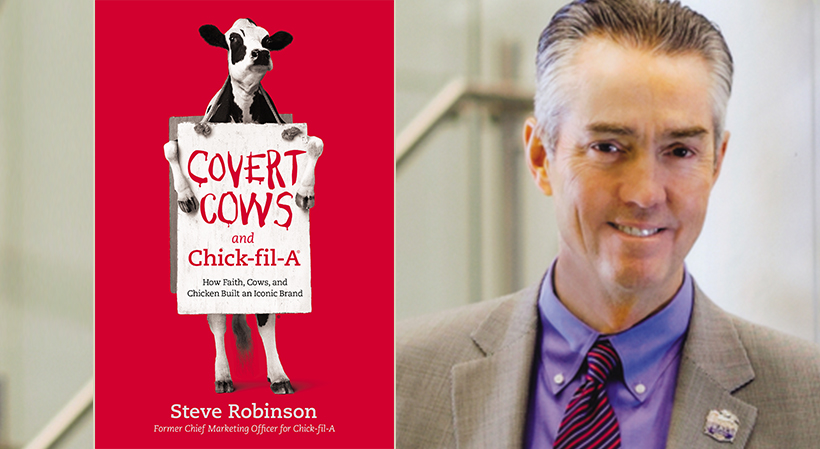The following excerpt is from “Covert Cows and Chick-fil-A: How Faith, Cows, and Chicken Built an Iconic Brand” by Steve Robinson.
Innovation has always been key to Chick-fil-A’s success, beginning with the creation of the sandwich itself. We continued to engage in an ongoing, living, constantly moving process of change in order to keep the brand relevant. Brand relevance, not just innovation for its own sake, was a top priority of the marketing group—to keep the brand relevant to customers’ lifestyles, tastes, and expectations.
Through the decades, we developed and honed a formal process where we systematically listened to customers and Operators as we innovated products, store designs, or hospitality initiatives. In the menu space alone, innovation led to Chick-fil-A nuggets and soup, waffle fries, and kids’ meals with toys that made a positive influence. When customers indicated they wanted us to step up our salad options beyond coleslaw and carrot and raisin salad, we wondered if they would buy a side salad. The answer, they told us very quickly, was yes. The success led us to develop an entire salad lineup.
Encouraged by the nutritional halo of side salads, we developed grilled chicken recipes that gave us both sandwich and salad options. Frank Carney and Shane Todd, veteran Operators in north Georgia, pioneered their own milkshakes, and when we saw the buzz they were creating, we took on the challenge. The new product development team worked to perfect the recipes, coordinating with suppliers to source the ingredients. We started with Frank’s and Shane’s proven milkshakes and worked on the recipe and procedures. But it was taking too long to prepare a shake. And we were burning up spinners and tearing up cups.
There wasn’t equipment on the market that could deliver a milkshake in our packaging fast enough. So our engineering team worked for almost two years to create and produce a mixer that could stand up to the volume and be easy to use in stores. The end result: milkshakes are now a huge part of the Chick-fil-A brand and experience.
Verizon Digital Ready: Providing Entrepreneurs the Skills and Knowledge They Need
Even as we were innovating as rapidly as we should and could, the marketplace became more demanding and more competitive, and we had to work harder to maintain our Blue Ocean space. The pace of required innovation demanded shorter cycle times, so under the leadership of David Farmer and a cross-functional team, we created a nearly one-hundred-thousand-square-foot innovation center, which opened in 2012. We named the facility “Hatch.” It allowed us to put the entire innovation process under a single roof, with full-size restaurant prototypes, virtual 3-D store design technology, and flexible workspaces. Hatch also allowed us to bring customers and Operators physically into the early stages of the innovation process.
We could brainstorm and get feedback on conceptual ideas, whether they were products, technology, advertisements, menu board layouts, or team member apparel. We got immediate customer feedback. We could prototype store designs, serve food, or exercise hospitality role-playing under the same roof. Before Hatch, the only “live” way to experience customer interaction with new ideas was in actual restaurants—a slower process.
In 2014, we created a separate space dedicated wholly to food, the Kitchen, a thirty-thousand-square-foot facility where we could work on new recipe ideas and improve existing products, procedures, and equipment to make kitchens safer and more efficient.
At any time, we had 15 or 20 projects going on in Hatch or the Kitchen, suggested by people throughout the organization. No matter their role or position in the business, anyone could champion a great idea. Innovation was most often fostered by folks closest to customers and Operators. When creative people worked in a creative environment where everybody around them was focused on innovation, that creativity became contagious.
Keeping the brand relevant through innovation also meant never losing the connection in the future with the past. For example, fresh design elements in many restaurants include a large table made from reclaimed wood for community seating. And over the table hangs a chandelier made by an Atlanta artist using Coca-Cola bottles that have been heated and flattened. The tables are made by men working through “A Better Way Ministries” to deal with life-controlling issues such as drug and alcohol addictions.
How to Start a Franchise Business
Innovating through organizational flexibility
We didn’t limit innovation to Hatch, the Kitchen, or the marketing department. In fact, we encouraged everyone throughout the organization, at the home office and in restaurants to share their ideas. We promoted innovative thinking by encouraging people to move around in the Chick-fil-A organization.
Nobody got pigeonholed. A field marketing rep or an IT professional or an advertising expert could do something else. Great thinkers continued to learn and seek new challenges and add value to everything they touched. They were rewarded financially and with fresh, challenging assignments, and they grew.
The company grew, as well. We created business generalists who then moved up through the organization and were better able to grasp the totality of the business. They could work on capacity or investment or marketing or store growth, and in a later context, help make better decisions.
As part of this commitment to developing talent outside the scope of their current responsibilities, every executive committee member had a formal mentor relationship with at least two people per year from outside their department. They made business trips together and spent time together regularly over lunch asking and answering questions in a completely transparent, completely confidential manner. The relationship allowed each to understand the other’s job and perspective on work.
As the staff grew in size, we expanded the program to other officer levels. It was not unusual for people to have outside coaches, but the best executive coach was often somebody already in the organization who was outside their department. The cross-departmental relationships illuminated the brand touchpoints circle from new points of view and triggered innovation.
“Covert Cows and Chick-fil-A: How Faith, Cows, and Chicken Built an Iconic Brand” is now available in hardcover, e-book and audiobook formats via StartupNation on Amazon. This excerpt is copyright © 2019 by Steve Robinson. Used by permission of Thomas Nelson. www.thomasnelson.com.






